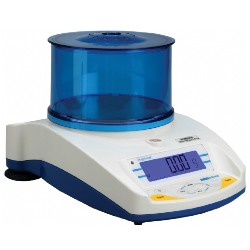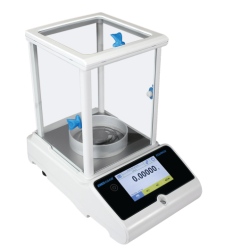What is a Top Load Balance?
A top loader balance is a balance without a built-in draft shield, so the pan is easily accessible from all sides. There are many kinds of top loader balances, including mechanical triple beam balances, compact balances, and precision balances.
Precision Balances
Precision balances often provide finer readability than compact balances because they intend to deliver highly precise weighing results. Unlike compact scales, precision balances offer more functions than weighing alone.
For example, the Adam Luna precision balance offers features like parts counting, check weighing, dynamic weighing, and percentage weighing applications. Our selection of Adam top loader precision balances ranges in capacity from 2100 grams to 15 kilograms, with readabilities going from 0.001 grams to one tenth of a gram.

Compact Balances
Compact balances, with their lightweight design, offer portability and occupy minimal space. They frequently feature batteries, enabling operation without requiring a power plug. Our Adam compact balances range in capacity from 100 grams to 30 kilograms, with readabilities from 0.001 grams to to five grams.
Triple Beam Mechanical Balances
Mechanical balances, like our Adam Equipment TBB Triple Beam Balances, operate without electricity. The weight of an object is determined by actively moving counterweights to physically balance the item. Our TBB Triple Beam Balances have capacities from 610 grams to 2610 grams, with readabilities of a tenth of a gram.
Summing up Top Loader Balances
Top-loading balances often are built using a robust housing and typically feature high capacities such as 2600 grams, 3200 grams or even 15,000 grams. However, they are much less precise and accurate than analytical balances, with readabilities ranging between 0.01 grams and 0.1 grams.
Top-loading balances are frequently used for material testing applications in construction and engineering where precision is still needed, but the balance cannot be as sensitive to minute changes because they are used in more demanding environments.
Top-loading balances are also very useful for applications where density is important, since they offer a large capacity with smart features that can do a lot of the work for the user.
They’re also well-suited for mobile laboratories where the conditions are less than ideal, and the samples are larger. Because they can weigh larger batches, top-loading balances are often used for pilot production or small batch production.

What is an Analytical Balance?
While analytical balances are slightly less precise than semi-micro balances (their readability tends to be around 0.0001g), they are usually used with an anti-vibration table to help minimize mass fluctuations caused by their environment.
They’re still very precise and pick up on slight changes, so precautions must be taken to accurately measure small samples. These types of balances are one of the most commonly used tools in a laboratory, from life sciences to forensics. Analytical balances are frequently used for quantitative analysis and reagent measurement in chemistry.
Analytical and semi-micro balances both feature draft shields that enclose a small weighing chamber designed to protect the sample from environmental factors like drafts or static electricity. They tend to share features such as formulation or percentage weighing.
Laboratories don’t only benefit from exceptional precision and accuracy – lab scales also offer additional applications, such as formulation, parts counting, check weighing and dynamic weighing. In the times of beam or spring balances, these extra calculations would have to be done manually. Now, you save time, money, and effort when using one of our Equinox, Luna or Solis balances.
Extraordinary scientific research and developments have come about thanks to scales and balances used in laboratories – yes, even before they became as accurate as the ones we use now. Imagine what will come!
How are Lab Balances Used in Research?
– Sample preparation, such as weighing compounds and solutions
– Analytical techniques like titrations and chromatography require precise weighing results to determine sample concentrations or purity
– Formulation & Quality Control for pharmaceutical research, ensuring accurate dosing and compliance with regulatory standards
– Environmental studies, including soil samples to determine ecosystem health and monitor pollutants.
The most common weighing instruments for laboratories are precision, analytical and semi-micro balances.
Load cells are transducers that convert force exerted onto it into measurable electrical output. When a weight is applied to a balance, the load cell located under the weighing pan bends, and the amount of force it takes to bend the load cell is converted to the result you get on the display.
Our range of Adam Equipment precision balances have capacities ranging from 120 grams to 22,000 grams, with readabilities from 0.001 grams to 0.1 grams. Our range of Adam analytical balances have capacities from 80 grams to 510 grams, with readabilities from 0.1 milligrams to 0.0001 grams – significantly more precise and accurate.
Which is better, Analytical Balances vs. Top Loading Balances?
As you can tell from reading the entry for today both analytical balances and top loaders have their place. So when you think of the question, Top Load Balance vs Analytical Balance? Your particular weighing needs will often determine which weighing device is the best for certain applications. In some instances, you may need both types of balances. Whichever you choose, make sure you choose a quality weighing device.
Generally speaking, analytical balances cost more and need to be used in a controlled setting. These scales are designed to be used in one location and are not very portable. The trade off however is an extremely accurate laboratory balance often with three or four decimal places of readability.
Top loading balances are typically built to be somewhat portable. Many of these top loading balances feature a rechargeable battery and robust construction. Top loading balances can be much more affordable as well. Top loaders also feature high max capacities for versatile weighing. However, the readability with top loaders is often limited to one or two decimal places.
Need help deciding on which precision weighing balances would work best for your application? Just contact our sales department (919) 776-7737 and we can assist you. We have a wide range of Adam Equipment balances. This line of precision weighing equipment is often considered to be one of the most affordable and reliable laboratory weighing equipment available in the United States.
